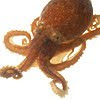We dug a new flower bed this weekend. Why? Because gardening is cheap entertainment. While digging up turf and cultivating the soil, we dug up a deadly little visitor. Ladies and gentlemen, I give you a millipede of the genus
apheloria...
This thing is about the size of my index finger.
I was curious what all the day-glow orange was about. Isn't that nature's way of indicating friendliness? No wait, it indicates danger.
After a quick google, it appears that the aphorelia millipede, when threatened, emits a cyanide compound from its flanks. ITS FLANKS. Was this millipdede designed by the KGB?
Sarah Moyer notes that
Apheloria corrugate is a chemistry marvel. It produces hydrogen cyanide (HCN). HCN, also known as cyanide, is a well-known poison that once inhaled will compromise the respiratory processes on a molecular level and in high enough doses result in death.
Storage of the HCN is a slightly complicated task. Since HCN is a gas at room temperature and could harm Apheloria corrugate if they stored it as HCN, their bodies are designed to store it in a special way. On both sides segments 5,7,9,10,12,13, and 15 to 19 of its body, they have two different chambers that each contain a different chemical that produce HCN when they are mixed.
When they want to defend themselves, they release the first chemical (mandelonitrile) from its storage chamber into the reaction chamber that contains an enzyme (benzoyl cyanide). Once these mix, they produce benzoic acid and HCN. It secretes from glandular pores located on each side of 11 segments of its body. They produce droplets that stay attached to the gland opening. Shortly after they secret HCN, the smell of bitter almonds will surface which will kill most of their enemies.
An adult Apheloria corrugate can produce as much as 0.6 milligrams of HCN. This is enough to kill ants and deter many of their other enemies. It's 6 times the lethal dose of a 25-gram mouse and 0.01 times the lethal dose of a human.
OK OK, so maybe .01x the lethal dose isn't technically deadly (unless you put 100 of the millipedes in your mouth, which is a remote possibility in this house), nevertheless, apparently the HCN is enough to make a person fairly ill. So yeah, we threw it over the fence into the backyard. Oops.
